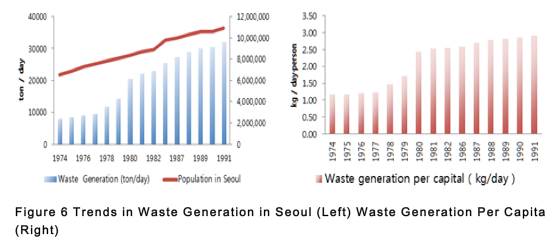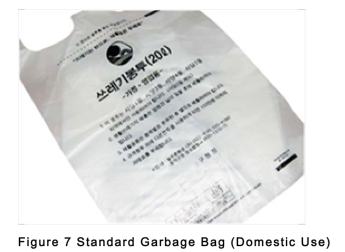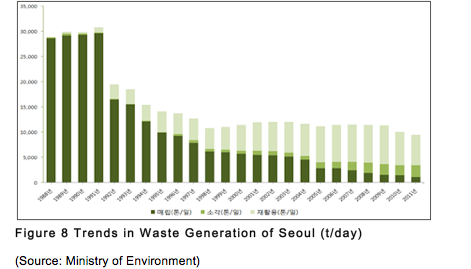首尔垃圾管理:垃圾处理费
ssues
As Seoul was making rapid economic developments in 1980s, the city’s waste volume skyrocketed as quick. As of 1991, the average daily waste generation per capita in Seoul was 3kg, remarkably large compared with 1.0kg in Japan, 0.9kg in the United Kingdom, 0.9kg in Germany. (Ministry of Environment, 2012) In particular, the helpless state of Nanjido Landfill Site against leachate and toxic gas leaks and other environmental problems it causes such as groundwater contamination asserted the need for controlling the demand for waste services.
Meanwhile, siting and construction of waste treatment facilities cause local resistance and became even more complicated in 1990s when the local autonomy system was introduced since mediating conflicts among local governments more difficult than ever. Though Seoul could secure site for Sudokwon Landfill Site, it was supposed to expire in 2006. It soon became evident that expanding waste treatment facilities could not meet the ever-increasing demand for waste treatment.

Despite the government’s effort to promote recycling and reduce waste generation, including the enactment of supporting laws, recycling rates remained very low at 5% until the late 1990s. Low incentive for households was pointed out as one reason behind the poor participation as waste collection was charged on a fixed rate through property tax or house size, which was criticized for being illogical. Under these circumstances, promotion of the recycling of wastes while minimizing its generation at the source surfaced as a main policy agenda.
Solution - Volume-Based Waste Fee System (VBWF)

Officially launched in 1995, Volume-based Waste Fee System employs economic incentives. Based on the “pay as you throw” principle, it charges according to the amount of waste discharge by selling mandatory standard bags. The implementation of the system entailed a significant change in public awareness toward waste disposal, drawing attention to such issues as the urgency of waste reduction and the costs of waste treatment. Increased perception of the system changed people’s behavior and resulted in support from citizens.
2.1. Planning
1) Preparation (1992.9 ~ 1994.12)
Before the full implementation, enforcement guidelines for the volume-based waste fee system were defined by the government. Meanwhile, public hearings took place to inform public officials, citizens and professionals from various fields on the new waste management system and to collect civic opinions. In the next couple years, the Ministry of Environment conducted a pilot operation in selected areas for each metropolitan city and province. As the pilot project showed positive results, other regions joined voluntarily. The citywide participation attained a remarkable 40% reduction in waste generation with the doubled recycling rate. During the preparation stage, the city went through extensive reviews and examinations on the new waste management system to solicit opinions from relevant ministries and different social sectors. Working with media for public promotion via television and radio was a responsibility of the headquarters and situation room of the Volume-based Waste Fee System
2) Introduction (1995.1.1)
On January 1, 1995, the Volume-based Waste Fee System launched nationwide. The previous waste collection fee was substituted with the pre-paid garbage bag produced by the local authority. The bags should be filled up to the dotted line and put out in front of houses, and recyclable materials should be separated into papers, bottles, cans, and plastic. As for the big wastes such as home appliances and furniture, the owner should report to the local office and wait and pay for the collection.
2.2. Implementation
1) Legal Framework
Legal ground for Volume-based Waste Fee System was from Article 13 and 14 of the 1991 Waste Management Act, and was supplemented with the 1995 revision. The guideline for Volume-based Waste Fee System by the Ministry of Environment provides frameworks for regional authorities’ ordinances. Based on the guideline mayors and district head officers decides bag prices depending on the type and amount of waste and are commissioned to operate manufacture, sales and distribution of the waste bags. (Korea Environment Institute, 2011)
2) Standard Waste Bag
The price of waste bags is determined based on the local ordinances, considering the previous garbage collection fee, the local government’s finances and the local standard of living. Whereas the previous method of waste collection used the flat-rate system, local governments’ financial status is reflected on bag pricing under the Volume-based Waste Fee System.
Waste bags are sold at places designated by local governments based on demand from households and businesses. Sales and distribution of bags for business purposes are commissioned to private companies.
| Capacity | 2ℓ | 3ℓ | 5ℓ | 10ℓ | 20ℓ | 30ℓ | 50ℓ | 75ℓ | 100ℓ |
| Average price | 52 | 72 | 99 | 187 | 363 | 547 | 897 | 1,363 | 1,840 |
Table 3 Price of Seoul Standard Garbage Bag (2012)
(Source: Seoul Metropolitan Government)
The composition and ingredients of standard waste bags vary. HDPE bags are primarily for incineration plants while HDPE bags are to be transported to landfills. The standard bags also vary in color and size depending on the purpose.
| Type of bag | Bag size |
| Domestic wastes (white) | 3ℓ, 5ℓ, 10 ℓ, 20 ℓ, 30 ℓ, 50 ℓ, 75 ℓ, 100 ℓ |
| Food wastes (yellow) | 1ℓ, 2ℓ, 3ℓ, 5ℓ |
| Business wastes (orange) | 5 ℓ, 10 ℓ, 20ℓ, 30ℓ, 50ℓ, 75ℓ, 100ℓ |
| Public purposes (blue) | 30ℓ, 50 ℓ, 100 ℓ |
| Construction debris, glass wastes | PP sack or gunny bag |
Table 4 Different Types and Sizes of Standard Waste Bag
1) Sales of Standard Waste Bags
Since 2005, sales of waste bags have constantly increased with the exception of 2007 in the wake of economic crisis. Starting in 2005, food waste was collected separately in special bags to be reused and this move has brought out a big reduction in profits from waste bag sales.
| Year | 2003* | 2004* | 2005 | 2006 | 2007 | 2008 | 2009 |
| Units sold (1,000) | 266,477 | 272,233 | 37,358 | 38,101 | 37,581 | 38,943 | 39,989 |
| Sales (KRW million) |
125,828 | 118,543 | 30,638 | 31,059 | 30,597 | 35,269 | 38,164 |
Table 5 Standard Waste Bag Sales of Seoul (Source: Korea Environment Institute, 2011)
2) Financial Viability of Cleaning Budget
The financial independence of the cleaning budget is come up by dividing the total profits from the sales of waste bag and recyclable materials, fees for the disposal of large-scale waste, and penalties by the annual waste disposal cost as shown in the following formula.
Financial Independence Rate = (revenue from sales of waste bags+ revenue from sales of recyclable materials+ large waste collection fees + etc.) / annual waste management cost
The financial independence rate of the Seoul’s cleaning budget is low at 34.6% as of 2009. It had an improvement of 1% between 2003 and 2004 from 35.4% to 35.4%. This implies the total spending on waste management usually exceeds the revenues from sales of recyclable materials and standard waste bags and large waste collection. The waste bags used for the cleaning of public facilities and bags subsidized for the underprivileged are purchased using local budgets. The cost for carrying waste into the final disposal facilities is also borne by local governments. In other words, revenue from collecting fees and commissions lower than the actual costs for the service is the reason behind the low financial independence rate in the cleaning administration. To leverage the fiscal independence of the cleaning budget, various measures including bag price raise are being examined by the authorities.
| Year | 2003 | 2004 | 2005 | 2006 | 2007 | 2008 | 2009 |
| Financial independence (%) | 35.4 | 24.4 | 43.2 | 35.1 | 35.2 | 35.0 | 34.6 |
Table 6 Financial Independence of Seoul's Cleaning Budget
(Source: Korea Environment Institute, 2011)
2.4. Challenges
1) Tackling Illegal Dumping
As expected during the initial stage of introduction, fraudulent activities were prevalent such as using unauthorized bags, illegal incineration and dumping. In particular, dumping of unauthorized bags was frequent in vulnerable places. Leaving trash in front of others’ houses or main streets was also common at that time. During the first major crackdown on illegal waste discharge practice, non-compliance to using standard bags accounted for 83% of the total reports (364617). (Lee et al, 1996)A number of enforcement tools were employed to tackle illegal practices. While employing monitoring personnel to monitor fraudulent activities, honorary citizen monitors were appointed and received education to help guide citizens in adapting to the new way of waste disposal. While the violators were imposed with fine, reporters of unlawful activities were rewarded with some amount below 80% of the fine charged to the reported violator for more effective prevention of non-compliance. (Korea Environment Institute, 2012)
2) Engaging Citizens
Separate collection of recyclable waste was first enforced in the entire districts in selected neighborhoods in Seoul in 1990, but the citizens' participation remained low until the introduction of Volume-based Waste Fee System in 1995. At the beginning, lack of public education and awareness caused confusion among citizen as to what is recyclable and how to dispose it. To enhance the public understanding the government held education sessions on ways to assort and reuse recyclables, and indicated recycling mark on the packing of recyclable goods.
Results
3.1. Output
1) Waste Reduction
As shown in the table above since 1991 the amount of waste disposed has been on the decline and especially had a big in drop of around 17.8% in 1995 compared to the previous year with the introduction of Volume-based Waste Fee System. The jump shown in 1998 is the result of the recovery from the IMF economic crisis in 1997.
2) Increased Recycling from Separate Waste Collection
Regulating waste discharge from the source, Volume-based Waste Fee System has brought about a dramatic improvement in waste generation and recycling practice, indicating a successful implementation. The new system provided a momentum in recycling practice; the amount of recyclable wastes collected daily multiplied over 18 times, jumping to 6592.7 tons within twenty years’ time.
3) Profit Generation and Cost Reduction
Economic benefits of Volume-based Waste Fee System include reduced waste management costs from the lower share of landfilling and incineration and economic value of recyclable goods. For the total profits of 20,293,220 million won yielded during the fourteen years from 1995 to 2009, the contribution of waste reduction was forty-six times bigger than that of recycling increase. However, the benefits of recycling resources still cannot be disregarded as it can facilitate waste reduction. (Yang et al. 2012)
3.2. Outcome
1) Diversification of Waste Treatment Methods
The method for waste treatment underwent substantial changes. To maximize the management efficiency of limited national land, the government has widened the policy scope to waste management away from the landfilling. The output of such a shit was waste generation. The reduced amount of waste discharged, in turn, extended the life of Sudokown Landfill Site.
2) Revitalization of Recyling Industry and Fostering Technological Advancement
As recycling becomes the norm, recycling industry has become a profitable business with stable supply of recyclable materials. Provision of government support to revitalize the recycling industry led to the increased number of recycling businesses and advancements in recycling technologies such as composting. In this way Volume-based Waste Fee System, helped to revitalize the recycling industry and foster its market competitiveness.
3) Improved Public Awareness of Waste Issue
One of the biggest accomplishments of the Volume-based Waste Fee System has been the improvement in public awareness of consumption and waste issues. The citizens started to opt for the environmentally friendly products that generate less waste and made adjustment in general consumption behaviors. Eco-friendly way of consuming became an established lifestyle; this involved efforts to use shopper bags instead of plastic bags, prevent food waste, reduce packaging, and avoid disposable materials. Furthermore, the changes in consumer behavior gave rise to active second-hand markets. The improved understanding and knowledge on the burden of waste management costs also encouraged citizens’ active engagement in waste issues and waste management policies such as separate collection. As another side effect, citizens in Seoul became increasingly environmentally aware, showing great understanding on ‘pay as you throw’ principle and actively engaging in environmental policies
Lessons Learned
1) Impacts of Economic Incentives
Volume-based Waste Fee System, the first environment policy to be implemented using economic incentives levies a waste collection fee based on the volume of waste discharged. This provides waste producers an incentive for waste reduction and encourages cooperation. By raising prices of the products and services that produces much waste, Volume-based Waste Fee System established a foundation for reducing the waste generated and eventually curtailing the amount of waste. The successful implementation of Fee Volume-based Waste System suggests that proper use of economic incentive can help cultivate sound public environmental awareness by encouraging civic engagements.
2) Importance of Public Environment Awareness
Volume-based Waste System is one example that public participation is a key success factor in pushing for waste reduction and recycling policies. With the help of a growing environmental awareness, a dramatic social improvement took place that resulted in a permanent behavior change toward recycling and waste issues for Seoul’s households and businesses. Instruments to encourage participation, such as public education sessions and campaigns, needs to be prepared before implementation